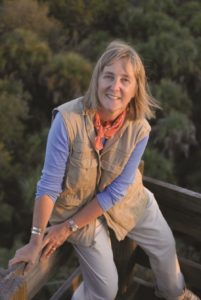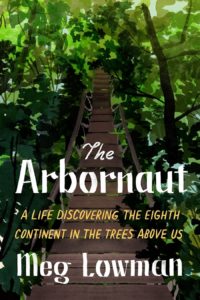By now, American field biologist Meg Lowman deserves to be a household name. In the 1980s, Lowman — sometimes known as “Canopy Meg” — pioneered the use of spelunking equipment to scale trees in endangered rain forests. She solved the mystery of eucalyptus die-off in Australia, shifting the blame from innocent koalas to guilty herbivorous insects. Lowman subsequently helped build the first canopy walkways — spectacularly engineered paths allowing non-specialists to explore the diversity of life way up high among the leaves.
Yet few will likely recognize Lowman’s name, despite the influence of her scientific research, teaching, and advocacy. This may be because Lowman has, until now, mostly published in the academic and scientific press. Her previous two memoirs — Life in the Treetops: Adventures of a Woman in Field Biology and It’s a Jungle Up There: More Tales From the Treetops — were published in 1999 and 2006, respectively, by Yale University Press. But with the release as a trade title last month of her wonderful new memoir, The Arbornaut: A Life Discovering the Eighth Continent in the Trees Above Us, Lowman should be poised to hit the big time.

In The Arbornaut, as in her other memoirs, Lowman combines personal narrative with accounts of her exploits researching in the field. She returns to her origin story as a shy but bright and curious child growing up in Elmira, N.Y. in the 1950s. Though she previously laid out the bare bones of her life story, Lowman has not until now explained in such depth how she fell in love with botany and ecology, how misogyny destroyed her first marriage in the Australian Outback, and how sexism repeatedly derailed her professional career.
What’s also new in The Arbornaut are stories of this intrepid explorer’s ecological adventures in India, Malaysia, Ethiopia, Kansas, and California. In mid-career, Lowman became an advocate who ran a botanical garden in Florida, led eco-tours to advance citizen science, helped set up the Nature Research Center in North Carolina, and partnered with island nations and for-profit businesses to save forests. Oh, and she also raised two sons as a single parent, encouraging them to publish with her and become top-notch scientists in their own rights.
Drawing on journal entries, Lowman, now 67, vividly describes the ways she has learned from people and the natural world across the span of her life. She brings readers into the scene as she floats atop a Cameroonian forest canopy in a dirigible and when she teaches wheelchair-bound science students to hoist themselves up into the California Redwoods.
Here she is at her best as a writer, recalling what it was like to demonstrate to priests in the Ethiopian Orthodox Tewahedo Church the extent of damage to their sacred thousand-year-old forests: “My old laptop sputtered with the frequent electric surges, but it held up. When the priests saw aerial images of their own forests, surrounded by brown dirt and dry croplands, they gasped. They had no access to computers, Google Earth images, or even a biology book to help them learn about island biogeography, which is an ecological concept applicable to forest fragments. Depicting these images in my talk helped me convey the urgent need to forge a partnership between religion and science, to conserve these green treasures.”
The priests, Lowman writes, did not have access to government or business funding. Partnering with a local researcher, they came up with some inspired solutions: refusing to replant forests with water-hungry species, insisting on situating cash-producing coffee groves underneath existing canopies, and recruiting villagers to build protective stone walls. “Building trust,” Lowman writes, “was the most valuable asset to achieve bottom-up or community-based conservation.”

Another lesson Lowman learned was that she and other pathbreaking species ecologists did not connect the changes they were seeing to climate change. It was exciting enough in the ’70s and ’80s simply to be discovering beetle life cycles in forests or fish feeding habits in coral reefs. But it took a relatively long time, she explains, to appreciate the relationships between these spans and habits and rising global temperatures.
“We were so consumed with figuring out how ecosystems functioned and how so many creatures coexisted,” she writes, “that we did not connect the dots and interpret the climate warning signs. Yes, we missed the forest for the trees.”
Through it all, Lowman has been an outspoken advocate for girls and women in science. She describes the frustration of “hitting the glass canopy” in academic departments and museums. Whether mentoring undergraduate science majors in America or inviting budding girl naturalists to join her in weeklong “bio-blitzes,” Lowman has made apparent her belief that gender bias has no place in classrooms or forests.
Lowman separates sections of her memoir with brief, loving descriptions of tree species. One of these, devoted to a strangler fig, allows her to expand on her convictions concerning women, inclusivity, and healthier models of leadership. Strangler figs have seeds that germinate “at the top with plenty of sunlight,” establishing “a latticework of downward-growing stems.” In time, the stems thicken and create a stable growth structure. A panoply of intersectional life forms depend on this structure, their interactions creating new opportunities.
This is the kind of environment, Lowman writes, that she wishes she’d experienced as a young woman in science. It’s the analogy she uses when she imagines herself in the future. Now a grandmother, Lowman writes that she intends to tell her sons’ children “about all the wonderful figs” she has encountered. The name she asks them to call her is “Mati,” rather than Grandma, which means “fig” in Samoan.
Mati is the nickname Samoan partners bestowed upon her when she worked with them to fund and build a canopy walkway. This walkway enabled them to raise enough money from ecotourism to build a school. They turned down a logging company’s offer to cut down the forest for a lump-sum payment. Now, the Samoans have a walkway to sustain themselves, future generations, and their fig forests.
